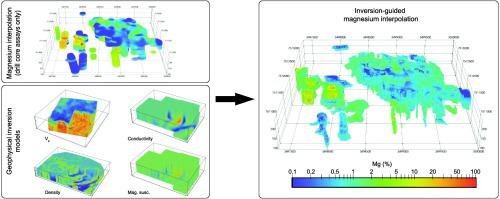Geoscience Frontiers ( IF 8.5 ) Pub Date : 2020-10-22 , DOI: 10.1016/j.gsf.2020.09.018 Tom Horrocks , Eun-Jung Holden , Daniel Wedge , Chris Wijns

|
3-D geochemical subsurface models, as constructed by spatial interpolation of drill-core assays, are valuable assets across multiple stages of the mineral industry's workflow. However, the accuracy of such models is limited by the spatial sparsity of the underlying drill-core, which samples only a small fraction of the subsurface. This limitation can be alleviated by integrating collocated 3-D models into the interpolation process, such as the 3-D rock property models produced by modern geophysical inversion procedures, provided that they are sufficiently resolved and correlated with the interpolation target. While standard machine learning algorithms are capable of predicting the target property given these data, incorporating spatial autocorrelation and anisotropy in these models is often not possible. We propose a Gaussian process regression model for 3-D geochemical interpolation, where custom kernels are introduced to integrate collocated 3-D rock property models while addressing the trade-off between the spatial proximity of drill-cores and the similarities in their collocated rock properties, as well as the relative degree to which each supporting 3-D model contributes to interpolation. The proposed model was evaluated for 3-D modelling of Mg content in the Kevitsa Ni-Cu-PGE deposit based on drill-core analyses and four 3-D geophysical inversion models. Incorporating the inversion models improved the regression model's likelihood (relative to a purely spatial Gaussian process regression model) when evaluated at held-out test holes, but only for moderate spatial scales (100 m).
中文翻译:

地球物理反演模型指导的3D地球化学插值
通过钻芯分析的空间内插法构建的3-D地球化学地下模型是矿物行业工作流程多个阶段的宝贵资产。但是,此类模型的准确性受到下面钻芯的空间稀疏性的限制,该稀疏岩心仅对地下的一小部分进行采样。可以通过将并置的3-D模型集成到插值过程中来缓解此限制,例如通过现代地球物理反演程序生成的3-D岩石特性模型,前提是它们已充分解析并与插值目标相关联。尽管标准的机器学习算法能够在给定这些数据的情况下预测目标属性,但通常无法在这些模型中纳入空间自相关和各向异性。我们提出了一种用于3-D地球化学插值的高斯过程回归模型,该模型引入了自定义内核以整合并置的3D岩石属性模型,同时解决了钻芯的空间邻近性和并置岩石属性的相似性之间的权衡问题,以及每个支持3-D模型对插值做出贡献的相对程度。基于钻芯分析和四个3-D地球物理反演模型,对提出的模型进行了3D建模,以评估Kevitsa Ni-Cu-PGE矿床中的镁含量。在保留的测试孔处进行评估时,合并反演模型可以改善回归模型的可能性(相对于纯空间高斯过程回归模型),但仅适用于中等空间尺度(100 m)。引入自定义内核以整合并置的3-D岩石属性模型,同时解决钻芯的空间邻近性和并置的岩石属性的相似性之间的权衡,以及每个支撑3-D的相对程度模型有助于插值。基于钻芯分析和四个3-D地球物理反演模型,对提出的模型进行了3D建模,以评估Kevitsa Ni-Cu-PGE矿床中的镁含量。在保留的测试孔处进行评估时,合并反演模型可以改善回归模型的可能性(相对于纯空间高斯过程回归模型),但仅适用于中等空间尺度(100 m)。引入自定义内核以整合并置的3-D岩石属性模型,同时解决钻芯的空间邻近性和并置的岩石属性的相似性之间的权衡,以及每个支撑3-D的相对程度模型有助于插值。基于钻芯分析和四个3-D地球物理反演模型,对提出的模型进行了3D建模,以评估Kevitsa Ni-Cu-PGE矿床中的镁含量。在保留的测试孔处进行评估时,合并反演模型可以改善回归模型的可能性(相对于纯空间高斯过程回归模型),但仅适用于中等空间尺度(100 m)。










































 京公网安备 11010802027423号
京公网安备 11010802027423号